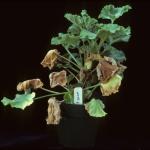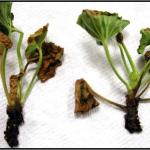Southern Bacterial Wilt
Southern bacterial wilt caused by Ralstonia solanacearum Race 3 Biovar2 was detected in geraniums in Massachusetts in 1999, 2003, and 2004. Growers should take precaution when encountering wilted, blighted geraniums as R. solanacearum Race 3 Biovar 2 is a federally quarantined pathogen that presents a serious risk to potato and tomato crops.
Importance
Southern bacterial wilt of geraniums is caused by two races of R. solanacearum, Race 1 and Race 3. Race 1 is found in the southern United States, and has occasionally affected geraniums in greenhouses or landscapes. Race 3, however, is not found in the United States, and is therefore regulated by a federal quarantine. R. solanacearum Race 3, Biovar 2, has valuable agricultural hosts as well as a few known ornamental hosts. It is of special concern to the potato industry in the United States and Canada, because Race 3 is a cold-temperature tolerant strain that has caused serious disease problems in potato crops in other temperate countries around the world.
Symptoms
Both races 1 and 3 of R. solanacearum produce symptoms that are very similar to those caused by Xanthomonas pelargonii. The main difference is that Ralstonia will cause wilting along with leaf yellowing and necrosis, whereas Xanthomonas can cause tiny, round leaf spots as well as wilt. Xanthomonas is only able to affect plants in the Geraniaceae family (including Pelargoniums and hardy geraniums). Ralstonia infects some ornamentals and vegetables within the Solanaceae family. Ralstonia is spread primarily within diseased cuttings, and can be transmitted from root system to root system by water movement such as recirculating subirrigation systems. Another method of transmission is through vegetative propagation of infected mother plants. Ralstonia is soil-borne and is not expected to be spread by overhead irrigation unless there was puddling around pot bases.
Symptoms of southern bacterial wilt are difficult to detect during winter months, but as temperatures rise in the spring, they become more obvious. Growers can speed symptom development by raising the daytime temperature. For example, at 81°F days and 68°F nights it takes 13 days for symptoms to develop, while at 75°F days and 64°F nights it takes 23 days.
What to do with suspicious plants
Since this is a regulated disease, any suspicious looking wilting plants, along with pots and soil, should be placed into sturdy garbage bags right at the bench and then held in a cool area until they can be tested. Don't carry pots with wilted plants out of the greenhouse; instead, bring the bag to them so that potentially contaminated growing medium won't be dropped on the floor. Do not discard wilted plants until a diagnosis is confirmed. Benches may be disinfected with a quaternary ammonium compound.
Don't assume that you have Ralstonia: remember that several different diseases and abiotic issues can cause symptoms similar to Southern bacterial wilt, so obtaining an accurate diagnosis is critical. For information on sample submission, please see the UMass Extension Plant Diagnostic Laboratory website or call (413) 545-3208. If Ralstonia is confirmed by the the lab, contact your supplier.
Tips for preventing spread of bacterial diseases
- Isolate new shipments of geraniums from the rest of your crops.
- Keep batches from different propagators separate from each other.
- Keep cultivars separate from each other.
- Keep seedlings, perennial geraniums and zonals separate from each other.
- Do not grow ivy baskets over seed or zonal geraniums.
- Work in blocks to prevent spread.
- Wash hands or change gloves often.
References
- Photo Library: Ralstonia on Geraniums
- Smith T. and Wick R. 2003. Disease alert: Southern bacterial wilt of geranium 15(5) pp 6-7.
- Additional web sites for pictures and information
http://www.aphis.usda.gov/ppq/ep/ralstonia/
http://www.pestalert.org/Detail.CFM?recordID=70
Massachusetts Introduced Pests Outreach Project

